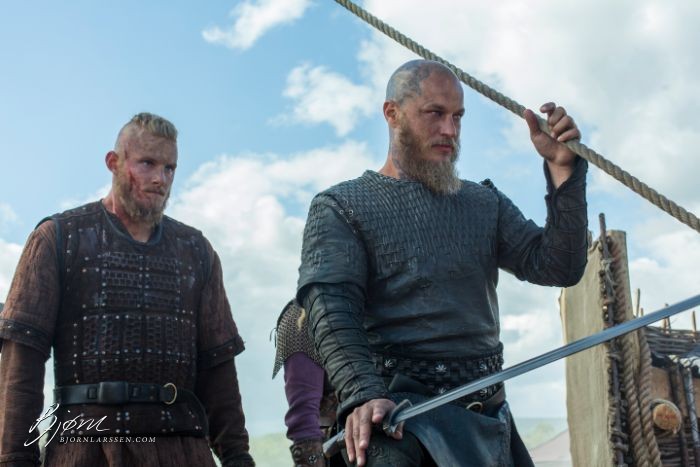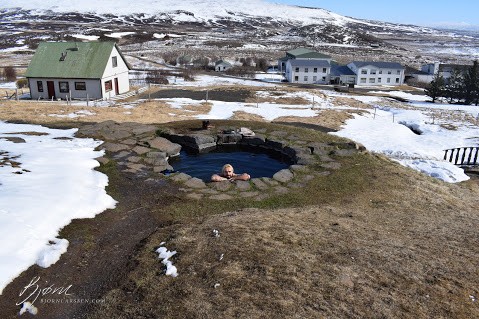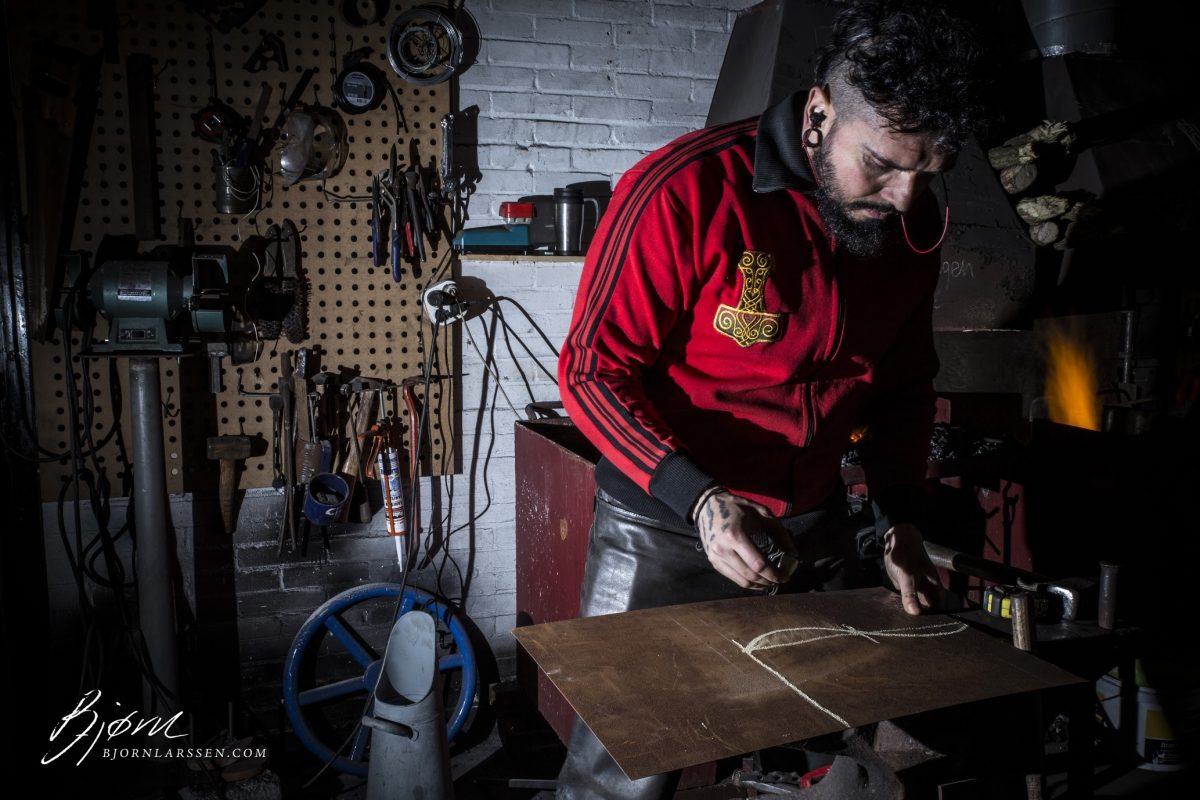
This post contains spoilers for seasons 1-4 of ‘Vikings’. You’ve been warned.
I’ve been a big fan of the ‘Vikings’ series, and in particular of Travis Fimmel’s character, since the first episode. I spent a while grinding my teeth at inaccuracies until I had to remind myself that Þórr, according to Marvel and Hollywood, is a clean-shaven blondie who wears a costume with six nipple shields. Later on I acquired ‘The World of Vikings’ by Justin Pollard and Michael Hirst (the series’ producer). The book shows very clearly that Hirst is not only well educated in the Viking history, but also has enough wits to understand that sometimes history doesn’t make very exciting TV. After reading the book, which by the way I wholeheartedly recommend, I forgave the inaccuracies. Especially as knowing history spoils the pleasure of watching, and any departures from facts – of “facts” – provides extra excitement.
You’ve probably read one of the “10 Facts About Ragnar Lothbrok That Will Change Your Life Forever” articles on the Internet. My take on this is a bit longer, features less illustrations, and also is more accurate – if you find any mistakes in this post, please point them out for me to fix.

I want to steal his entire wardrobe. If such shocking theft ever happens, I was joking and you can’t prove anything.
Let’s start with the big one. When was Ragnar born? Ha. Gotcha. There is no proof whatsoever that Ragnar existed at all. In 1979, Hilda Ellis Davidson wrote:
Certain scholars in recent years have come to accept at least part of Ragnar’s story as based on historical fact.
Note the careful wording of ‘certain scholars’ and ‘at least part’.
In 2003, Katherine Holman disagreed:
Although his sons are historical figures, there is no evidence that Ragnar himself ever lived, and he seems to be an amalgam of several different historical figures and pure literary invention.
Holman’s view seems to be the most accurate, at least with the knowledge we possess today. It’s also very Ragnar, so to say, to not even exist, yet have many sons whose existence is proven beyond all doubts.
Lagertha

Lagertha (Katheryn Winnick) on a bad hair day
Ragnar’s first wife was a shieldmaiden named Lagertha (Old Norse: Hlaðgerðr). She wasn’t a delicate flower. Saxo Grammaticus:
Ladgerda, a skilled Amazon, who, though a maiden, had the courage of a man, and fought in front among the bravest with her hair loose over her shoulders. All-marvelled at her matchless deeds, for her locks flying down her back betrayed that she was a woman.
(Yes. Saxo was sexist. I hope this isn’t surprising. In his defence, he died approximately 800 years ago.)
Lagertha wasn’t particularly into Ragnar, even though he hadn’t begun to wear his hairy breeches (see below) yet. As he courted her, impressed by her courage in battle, Lagertha gracefully invited him over for tea and light refreshments. Her idea of hospitality involved setting a bear and a great hound upon him. Ragnar killed both beasts, which impressed Lagertha so greatly they ended up with three children: son called Fridleif Ragnarsson, and two daughters whose names have not been recorded. None of those three children are mentioned in the TV series.
Lagertha did not bear him a son called Björn. While Lagertha existed as a historical figure, most of the stories surrounding her are considered to be Saxo Grammaticus’s inventions. Saxo, of course, did not approve of the idea that a woman does anything else than giving birth, cooking, and crying as her husband goes away to war, therefore Lagertha served him as an example of how horrible heathens must have been. Ragnar divorced her later in order to marry Þóra Borgarhjǫrtr (not pictured on TV).
Lothbrok = Hairy breeches
The story behind the name ‘Lothbrok’ is a variation on Polish and Russian folk stories. (Aside: Vikings spent surprising amounts of time in Poland and Russia.) The origin of the name comes from Ragnar’s desire to marry Þóra. Her doting dad, Herrauðr, presented her with a small lindworm (according to Wikipedia – “wingless serpentine monster”). This struck me as a somewhat odd gift, especially when the lindworm grew uncontrollably, eventually trapping poor Þóra in her dwelling. Herrauðr promised her hand in marriage to the man who would slay the serpent. The sources do not mention what Herrauðr would have done if the beast was slain by a woman, but a man who literally surrounds his daughter with something that serves as giant phallic symbol probably never spent too much time thinking of shieldmaidens and Valkyries. In the story, Ragnar put on trousers made of fur, then covered himself with tar in order to kill a snake. The snake must have been somewhat bewildered by the sight of tar-smeared Travis Fimmel, yet the trousers proved to be great defense against snake venom. Ragnar, in his excitement, decided those pants were suitable for all occasions and made a habit of wearing them. I suppose, however, that Þóra was happy enough to be able to go for a nice, serpent-free stroll and allowed her husband to continue donning such a handy protective garment. Unfortunately, once Þóra gave Ragnar two songs, Eiríkr and Agnar, she died of illness.
You will note none of the people mentioned in the passage above appear in the TV series either, and if I remember correctly neither do his hairy breeches. As a side note, none of his wives changed their surnames to “Lothbrok” for the simple reason that it wasn’t his surname, but a nickname.
Lagertha didn’t get over Ragnar all that fast, which was very helpful when he fought a civil war in Denmark. At the time she was the queen of Norway and sent over 120 ships to help her ex. Upon her return home, she killed her husband and became the ruler of Norway. This was pictured in ‘Vikings’. I think it’s safe to say Lagertha did not have much luck in love. What Saxo had to say about this was quite predictable: she “usurped the whole of his [her husband’s] name and sovereignty; for this most presumptuous dame thought it pleasanter to rule without her husband than to share the throne with him”. How presumptuous of the dame!
Aslaug

Aslaug (Alyssa Sutherland) looking awesome and magical – like always.
The third wife of Ragnar was Aslaug, daughter of legendary Sigurd, slayer of a dragon, and shieldmaiden Brynhildr. None of her parents is considered to be a real historical figure, as the slaying of the dragon might have already suggested. There was no exciting rivalry between her and Lagertha, since Lagertha was busy killing her husband and ruling Norway. But there’s more to Aslaug’s story.
Her foster father, Heimer, was concerned about the girl’s safety. He decided to make a harp, inside which he hid the little Aslaug. It is hard for me to understand why he thought a harp would be the best place to hide a child, but I suppose a piano would have been even harder to carry around. Upon their arrival in Norway Heimer stayed over for the night in the house of peasants Áke and Grima. Grima, who was certain the harp must have been filled with valuables – after all, what warrior would feel like carrying a harp around – made her husband kill Heimer. Grima must have been quite disappointed to find a girl instead of gold and jewels, nevertheless they renamed her Kráka (Crow) and raised as their own.
Kráka, who was a beautiful lady, didn’t quite fit in the household, therefore Grima decided she needed to be rubbed in tar and dressed in a long hood at all times. Upon meeting Kráka Ragnar immediately 1) fell in love (he had experience with tar, which might have helped), and 2) decided to marry her. However, fickle as he was, he decided to marry Ingeborg, a daughter of a viceroy named Eysteinn Beli. Very unimpressed by his undecisiveness, well-informed Kráka decided to share the information about her noble origins with Ragnar. It is not known how she knew she was a noblewoman, but possibly the harp contained her birth certificate as well. Eysteinn, understandably, was not impressed by this change of mind. He died at the hands of…
Ragnar’s sons

Four out of many sons of Ragnar (from left: David Lindström as Sigurd, Alex Høgh Andersen as Ivar The Boneless, Jordan Patrick Smith as Ubbe, Marco Ilsø as Hvitserk)
Speaking of sons, Aslaug and Ragnar had five: Ivar the Boneless; Björn Ironside; Hvitserk; Rognvald; and Sigurd Snake-in-the-Eye. Sigurd was born with the image of Ouroboros (or perhaps the Midgard Serpent) in his eye due to Ragnar’s impatience to consummate the marriage despite Aslaug’s insistence to wait a bit longer. Aslaug prophecied the mark in Sigurd’s eye. She also prophecied that Ragnar’s invasion of England wouldn’t go well due to the fact his fleet was in bad shape, and she was right. Ever so careful Aslaug provided her husband with a magical shirt, which would prevent him from snake venom. Somehow, the shirt was removed after Ragnar was cast into the snake pit, and only then did he die. I assume his breeches were too worn out at this point for him to continue wearing them. Big mistake. Huge.

King Aelle looking sepulchral (Ivan Kaye)
As I mentioned, it is not known whether Ragnar actually existed at all, was an amalgam of stories of multiple other warriors, or simply a mythological figure. The confusion is aided further by the multiple stories describing his death. As we’ve seen on TV, King Ælla decided to throw him into a snake pit, but according to sources Ælla did so not knowing he was dealing with Ragnar Lothbrok himself. Ragnar must have felt rather aloof, refusing to inform Ælla about his credentials even as he was already in the snake pit. This clashes with the much less romantic version of the story, according to which Ragnar died of illness in France. He did, however, kill a lot of Franks first.
To sum things up:
– ‘Vikings’ TV series skips one wife. I’ll admit Lagertha and Aslaug are quite a handful without Thóra’s help.
– None of the children he had with Thóra and Lagertha are featured in the TV series.
– Björn Ironside was the son of Aslaug, same as all the other ones featured in the TV series. The departure from sources was necessary to create a very exciting conflict between him and (TV) Aslaug’s sons.
– While it is accepted that Ragnar’s sons existed, there is a theory (see Ben Waggoner’s book) that multiple warriors called themselves “Ragnar’s sons” in order to scare their opponents or make themselves look more important.
– As shown on TV, Ragnar demanded that Aslaug shows up in his camp “neither dressed nor undressed, neither fasting nor eating, and neither alone nor in company”, which strikes me as rather demanding seeing as he wanted to marry her, not the other way round. Honestly, Ragnar? Your way of dealing with the ladies should not be an example to any of the people reading this post. Actually, your habit of killing tons of people wherever you go shouldn’t either.

Travis Fimmel, who has no business looking THAT good
I can also exclusively reveal that Rollo, Ragnar’s brother in the TV series, never actually met Ragnar, not to mention the fact they were not related. More on Rollo soon, because any excuse is good to post photos of pre-awful-haircut-and-handlebar-moustache photos of Clive Standen.
*
All photos used are promotional materials for the ‘Vikings’ TV series, property of History Channel.
*

Subscribe to my newsletter and receive a free e-book (released March 17 with the next newsletter) – Vikings: from history to History, featuring rewritten and greatly expanded versions of the posts from the Deconstructing ‘Vikings’ series. The book includes chapters on Ragnar Lothbrok, Lagertha, Áslaug, Björn Ironside, Ivar the Boneless, Ivar’s brothers, Flóki, Harald Fairhair and Halfdan the Black, and Athelstan.
Other posts in the series:
Deconstructing ‘Vikings’: Rollo
Deconstructing ‘Vikings’: Flóki
Deconstructing ‘Vikings’: Harald Fairhair and Halfdan the Black
Photos: promotional materials of History Channel
 Confession: I have a Scottish fetish. To be more precise, it’s Scottish accent/dialect fetish. I need subtitles to understand what, say, Sharleen Spiteri says in interviews, but damn, does she sound amazing! When I found out Outlander, the TV series, existed I just had to jump in. Scots! Kilts! Someone called Jamie that apparently is worth watching!
Confession: I have a Scottish fetish. To be more precise, it’s Scottish accent/dialect fetish. I need subtitles to understand what, say, Sharleen Spiteri says in interviews, but damn, does she sound amazing! When I found out Outlander, the TV series, existed I just had to jump in. Scots! Kilts! Someone called Jamie that apparently is worth watching!
 In my second work-in-progress novel (WIP2) the main protagonist utters the following phrase: “A responsible adult should be taking care of this, not me!” It’s not a good thing when a fictional character speaks with the writer’s voice, but Gareth and me are in 100% agreement over this. Gareth, by the way, is 32. I am 40.
In my second work-in-progress novel (WIP2) the main protagonist utters the following phrase: “A responsible adult should be taking care of this, not me!” It’s not a good thing when a fictional character speaks with the writer’s voice, but Gareth and me are in 100% agreement over this. Gareth, by the way, is 32. I am 40. Business Insider:
Business Insider:



 As mentioned previously, I am working on two books at once.
As mentioned previously, I am working on two books at once.





















